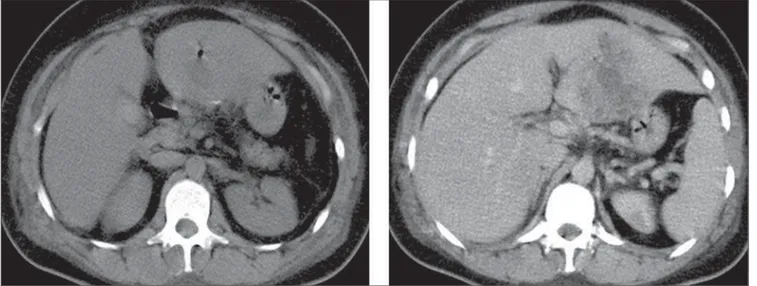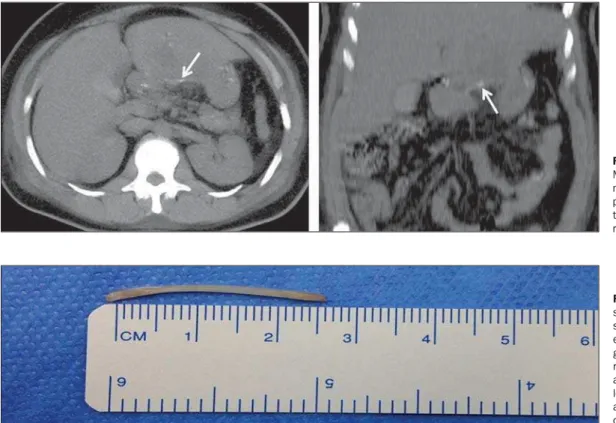XV
Radiol Bras. 2013 Jan/Fev;46(1):XV–XVI
Walter Luís Frare da Silva1, João Maurício Canavezi Indiani2, Marcelo Fontalvo Martin2, Rodrigo Ciotola Bruno3, Luiz Arnaldo Szutan4, Marcelo Souto Nacif5
0100-3984 © Colégio Brasileiro de Radiologia e Diagnóstico por Imagem
WHICH IS YOUR DIAGNOSIS?
Silva WLF, Indiani JMC, Martin MF, Bruno RC, Szutan LA, Nacif MS. Which is your diagnosis? Radiol Bras. 2013 Jan/Fev;46(1):XV–XVI.
A 47-year-old female patient was admitted to the emergency department presenting abdominal discomfort for ten days, with stitch pain in the epigastric region. The patient reported worsen-ing with fever over the last three days. No history of previous disease was reported. Laboratory tests demonstrated leukocyto-sis with no deviation. Considering the intensity of the epigastric pain, the patient was referred for endoscopy which demonstrated Study developed at the Unidade de Radiologia Clínica (URC) and at Hospital Vivalle, São José dos Campos, SP, Brazil. 1. Physician, 3rd year Trainee at Unidade de Radiologia Clí-nica (URC), São José dos Campos, SP, Brazil. 2. MDs, Radiologists, Unidade de Radiolo-gia Clínica (URC), São José dos Campos, SP, Brazil. 3. Master, MD, General Surgeon and Coloproctologist, Hospital Vivalle, São José dos Campos, SP, Brazil. 4. Associate Profes-sor, Faculdade de Ciências Médicas da Santa Casa de São Paulo, Head of the Group of
Liver Surgery, Santa Casa de São Paulo, São Paulo, SP, Brazil. 5. PhD, Professor, Depart-ment of Radiology, Faculdade de Medicina da Universidade Federal Fluminense (UFF), Niterói, RJ, Brazil. Mailing Address: Dr. Marcelo Souto Nacif. Rua Barão de Cocais, 324, Bosque Imperial. São José dos Campos, SP, Brazil, 12242-042. msnacif@huap.uff.br / www.msnacif.med.br.
the presence of an elevated lesion in the antrum, measuring ap-proximately 1 cm, and umbilication covered by fibrin. Biopsy was performed.
The patient progressed with worsening of the pain, remain-ing febrile but with no sign of peritonitis. Abdominal non-contrast-enhanced and contrast-non-contrast-enhanced computed tomography was per-formed (Figures 1 and 2).
Figure 1. Abdominal computed tomography before and after intravenous contrast injection.
XVI Radiol Bras. 2013 Jan/Fev;46(1):XV–XVI
Images description
Figure 1.A: Predominantly hypodense, expansile, loculated mass with anfractuous contours, measuring 8.1 cm × 6.2 cm, pre-senting peripheral, heterogeneous contrast enhancement, located in the left hepatic lobe (segments II and III). The presence of intermingled gas bubbles is observed. B: A hyperdense linear image is observed in close contact with the left hepatic lobe. Such image remained unaltered along all the study phases.
Figure 2. Axial and coronal MIP recon-structions at non-contrast-enhanced phases, demonstrating the presence of a hyperdense linear image in close contact with the left hepatic lobe. Observe the small gastric curve in close contact with the left hepatic lobe.
Diagnosis: Pyogenic liver abscess caused by a foreign body which perforated the small gastric curvature.
COMMENTS
Liver abscess caused foreign body is a relatively rare condition of difficult diag-nosis(1) and was firstly described in 18982,3. The greatest majority of cases are caused by tooth-picks, fish-spine (Figure 3) and
dental prostheses(1,3,4). The degree of
sus-picion by health professionals is limited, since the symptoms are varied and nonspe-cific. Moreover, most of patients do not promptly report the foreign body inges-tion(1,2).
Most ingested foreign bodies (Figure 4) pass through the gastrointestinal tract asymptomatically in a seven-day time span
(3). In cases of development of a liver
ab-scess, the site of penetration into the gas-trointestinal tract cannot always be identi-fied, but normally it results from perfora-tion of the stomach, duodenum or trans-verse colon, with tamponade of the liver parenchyma or direct penetration of the foreign body(1). Usually, the foreign body
lodges in the left liver lobe(1,2), which leads
to increased diagnostic suspicion as an abscess is identified in this region.
Imaging methods, particularly com-puted tomography, present excellent sensi-tivity in the characterization of abscesses, besides allowing the identification of the foreign body, like in the present case(1,5).
The lesion is typically round-shaped, with well defined walls, and may be either soli-tary or multiple. The variation in density depends on the necrosis intensity and the phase of the pathological process(5). The
treatment comprises antibiotic therapy, abscess drainage and foreign body re-moval.
FINAL CONSIDERATIONS
Liver abscesses caused by foreign body generally lead to death because of late di-agnosis in most of cases(5). Other etiologies
should be sought in the absence of response to aspiration or drainage and antibiotic therapy. Despite the rarity of such an event, the presence of a foreign body must be taken into consideration, with an active search for radiographic/tomographic signs to identify the object and aid in the thera-peutic surgery(2).
REFERENCES
1. Liu HJ, Liang CH, Huang B, et al. Migration of a swallowed toothpick into the liver: the value of multiplanar CT. Br J Radiol. 2009;82:e79–81. 2. Borba CC, Gomes ARS, Filgueira JPPS, et al.
Abs-cessos hepáticos secundários a espinha de peixe. Relato de caso. Rev Bras Clin Med. 2012;10:83–6. 3. Santos SA, Alberto SCF, Cruz E, et al. Hepatic abscess induced by foreing body: case report and literature review. World J Gastroenterol. 2007;13: 1466–70.
4. Waisberg J, Aráuz SNZ, Altieri LG. Abscesso he-pático piogênico por corpo estranho. Rev Col Bras Cir. 2002;29:240–1.
5. Silva RF, Junior PCA, Duca WJ, et al. Abscesso hepático por osso de peixe. Arq Ciênc Saúde. 2006;13:61–3.
Figure 3. Axial and coronal MIP reconstructions in the n o n - c o n t r a s t - e n h a n c e d phase, identifying a hyperin-tense linear mass (arrow) representing the foreign body.

